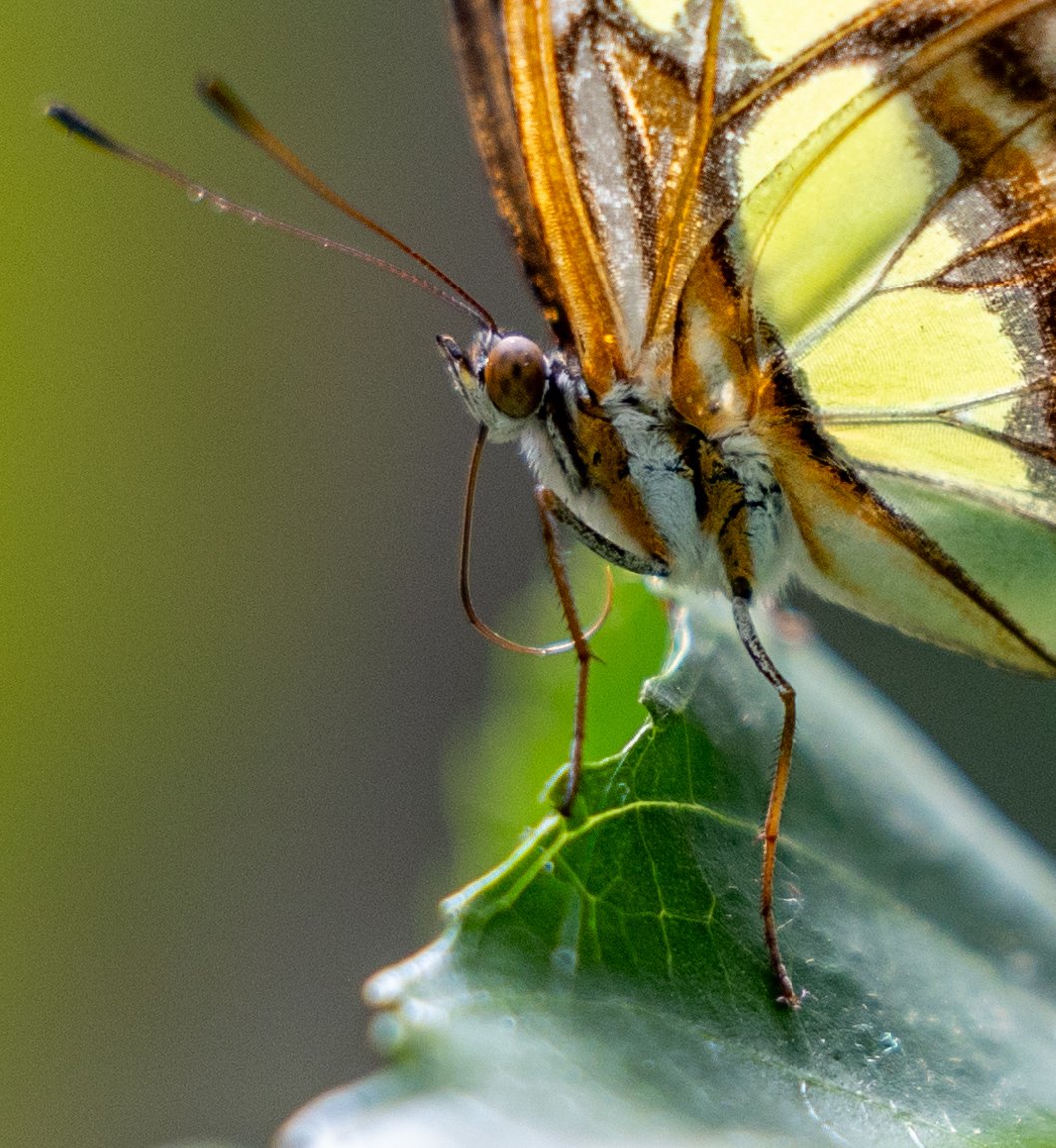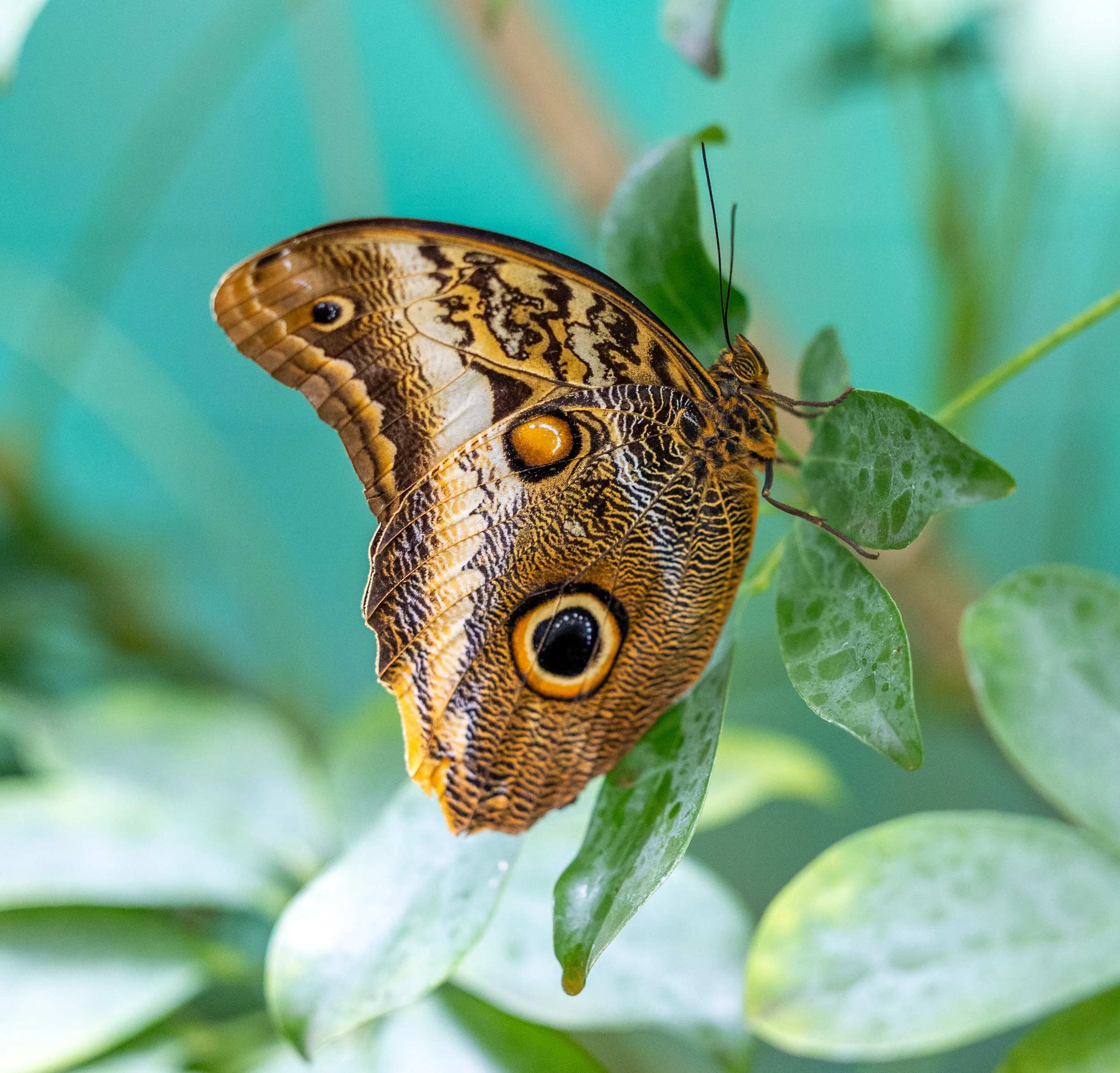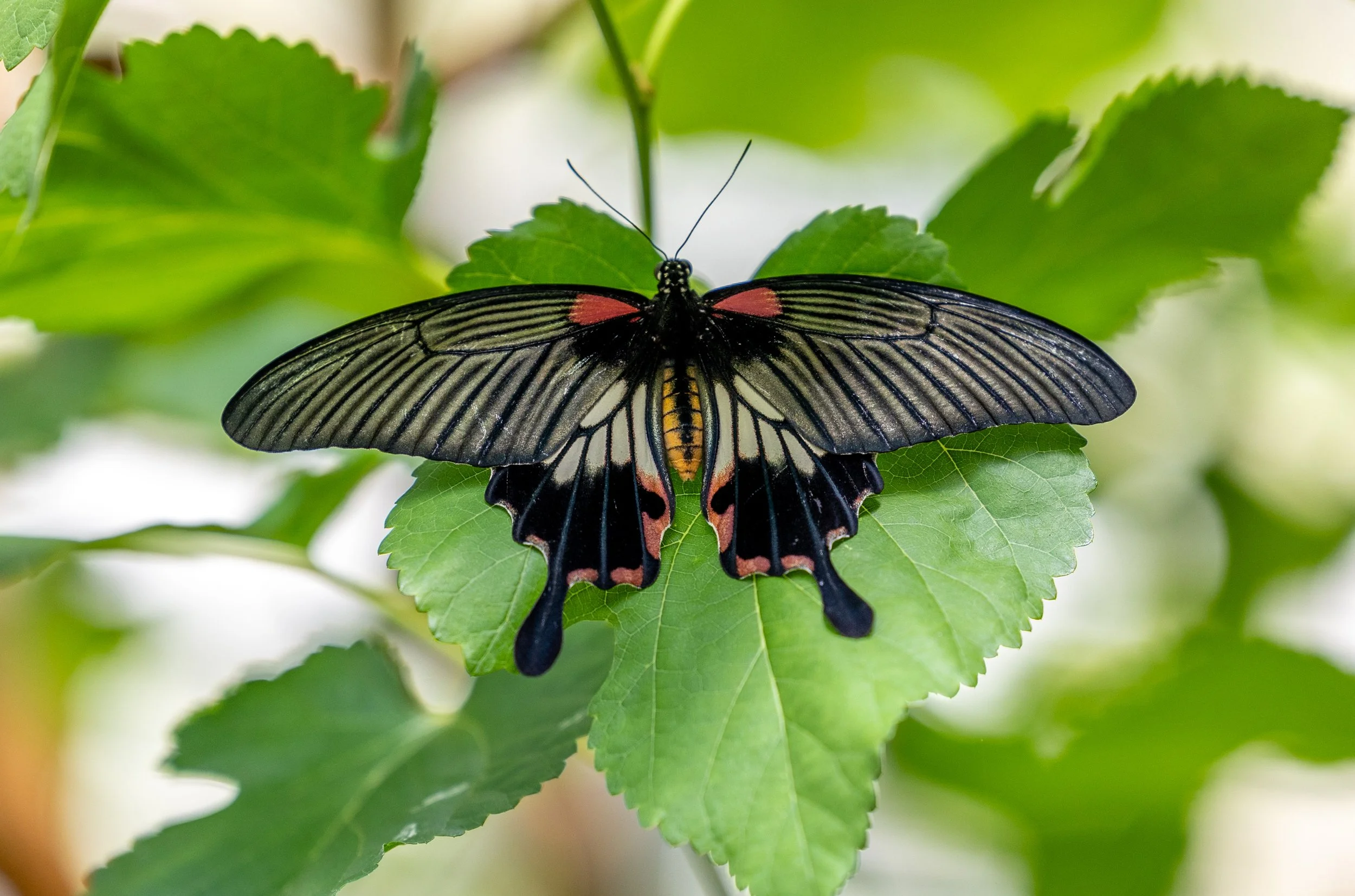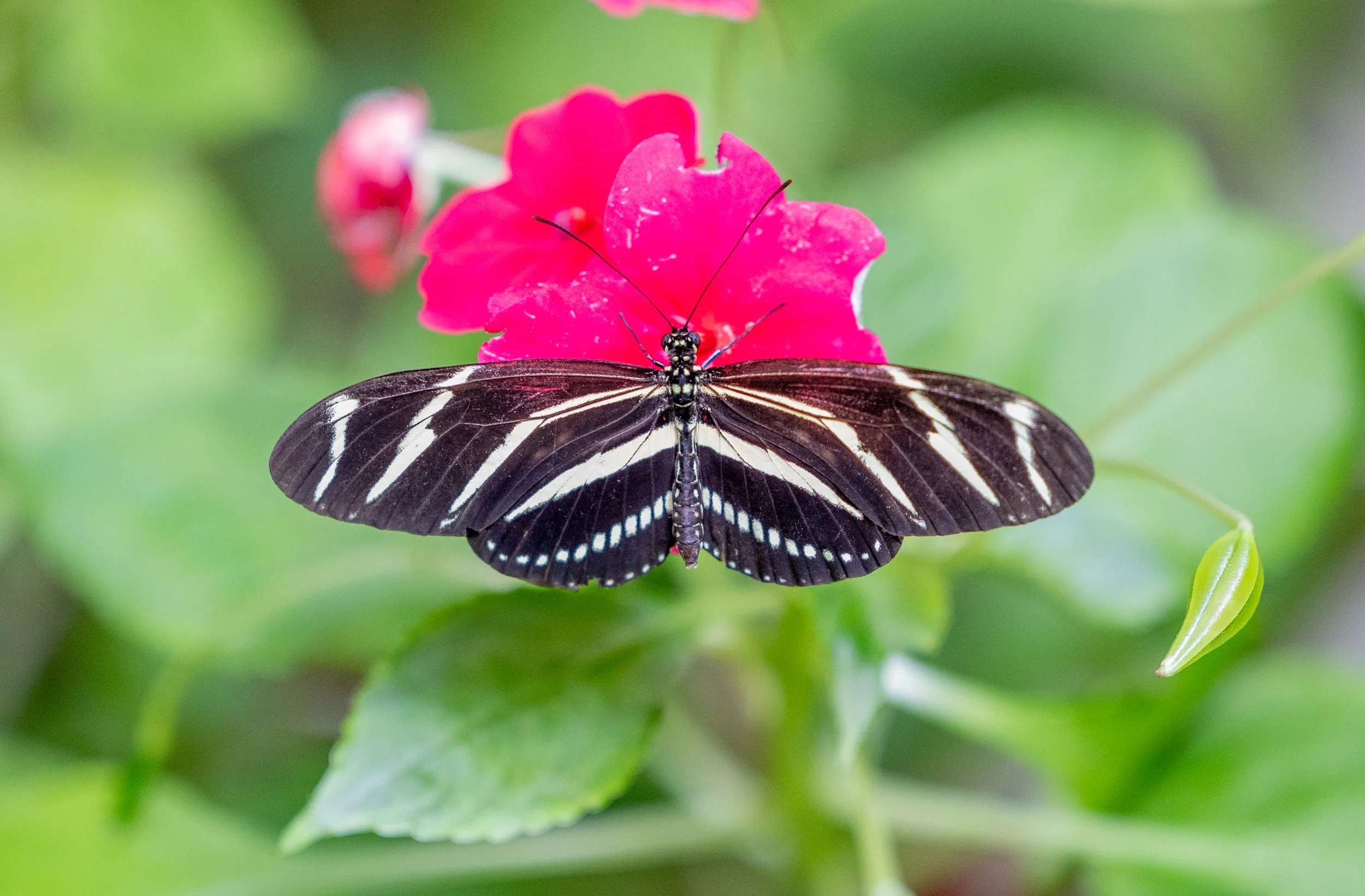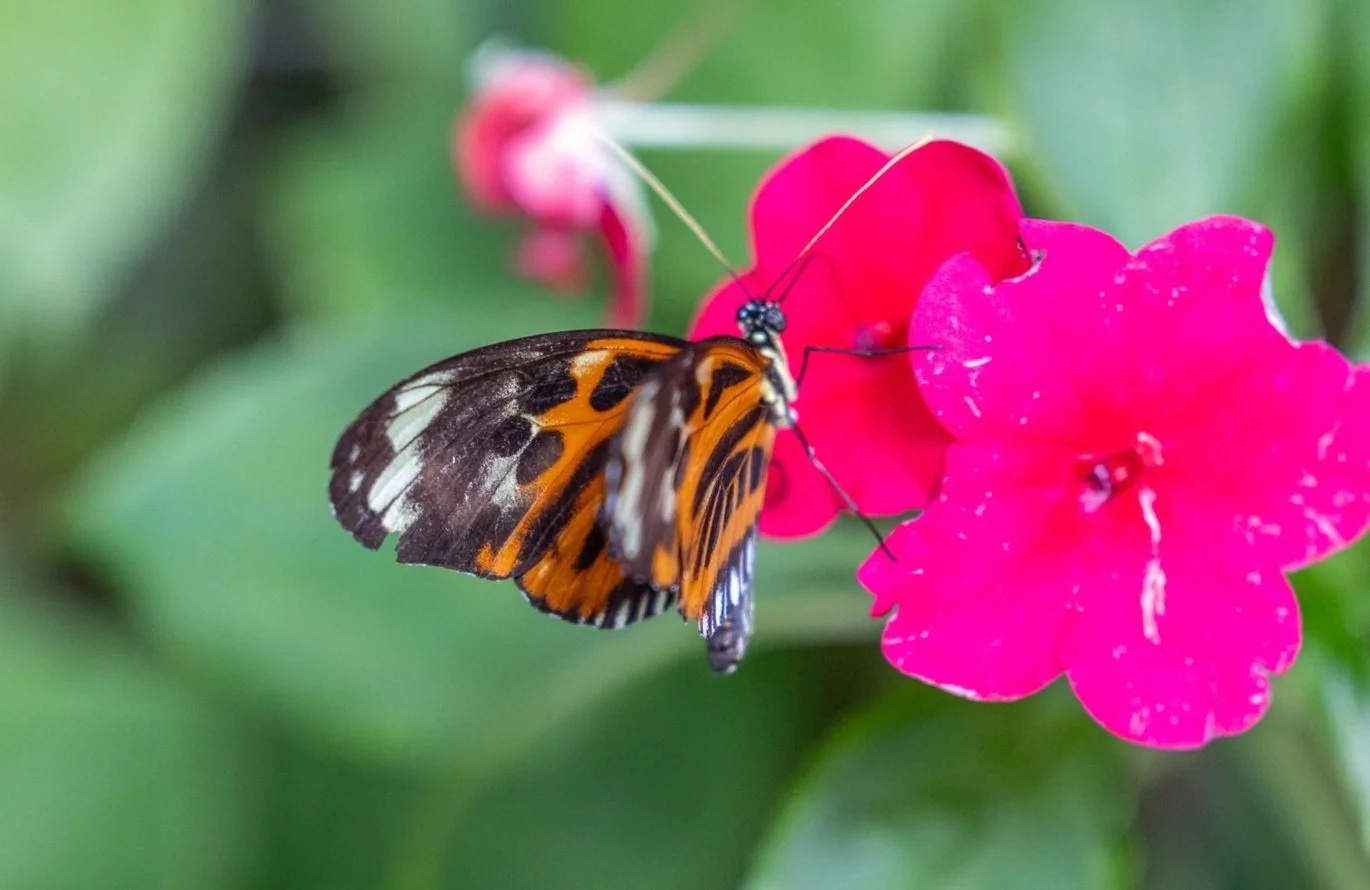Butterflies
Butterflies are colorful, winged insects belonging to the order Lepidoptera, which also includes moths. They undergo a complete metamorphosis with four life stages: egg, larva (caterpillar), pupa (chrysalis), and adult. This transformation allows them to adapt to different environments and roles during their life. Butterflies play an important role in ecosystems as pollinators and as a food source for other animals. They are also sensitive to environmental changes, making them useful indicators of biodiversity and habitat health. Their vivid wing patterns not only aid in camouflage and predator deterrence but also attract mates.
Cabbage White Butterfly
The Cabbage White Butterfly (Pieris rapae) is a common species found in Europe, Asia, and North America. It is easily recognized by its white wings with one or two black spots on each forewing and a black wing tip. The caterpillars, known as cabbage worms, primarily feed on plants in the Brassicaceae family, such as cabbage, broccoli, and kale, making them significant agricultural pests. Adult cabbage whites are active during the day and are strong fliers, often seen fluttering around gardens and fields. They typically produce multiple generations per year, especially in warmer climates, and their adaptability has helped them thrive in a wide range of environments.
Eastern Tiger Swallowtail
The Eastern Tiger Swallowtail (Papilio glaucus) is a large, striking butterfly native to eastern North America. It is easily recognized by its yellow wings with black tiger-like stripes and a wingspan that can reach up to 5.5 inches. Females can be either yellow like the males or dark (mimicking the poisonous Pipevine Swallowtail), a phenomenon known as dimorphism. This species is commonly found in deciduous woodlands, gardens, and near water sources. The caterpillars feed on a variety of host plants including tulip trees, wild cherry, and ash, while adults feed on nectar from flowers like milkweed and phlox. The Eastern Tiger Swallowtail typically produces two to three broods per year, especially in warmer regions.
Male Great Mormon Butterfly
The male Great Mormon Butterfly (Papilio memnon) is a large, sexually dimorphic swallowtail species found in South and Southeast Asia. Males are typically dark blue or black with a glossy sheen and lack the tails seen in many swallowtail species, distinguishing them from the more variable and often brightly colored females, which mimic toxic butterfly species as a defense mechanism. With a wingspan ranging from 12 to 15 cm, the male Great Mormon is a strong, fast flyer and is often seen feeding on nectar from a variety of flowering plants. It inhabits tropical and subtropical forests, as well as gardens and plantations. The larvae feed on citrus plants and other members of the Rutaceae family, making the butterfly both ecologically important and of interest to agriculture.
Owl Butterfly
Owl Butterflies, belonging to the genus Caligo, are large butterflies native to Central and South America, known for the prominent eye-like spots on their wings that resemble owl eyes. These eyespots, primarily on the underside of their hindwings, serve as a defense mechanism to deter predators by mimicking the eyes of larger animals. Owl Butterflies typically have a wingspan ranging from 4.7 to 7.9 inches, and their upper wings are usually dull brown, while the underside features intricate patterns for camouflage. They are crepuscular, meaning they are most active during dawn and dusk, which helps them avoid daytime predators like birds. The larvae feed on banana and heliconia plants, making them both a curiosity and a mild pest in banana plantations. Adults primarily feed on rotting fruit, using their long proboscis to extract juices.
Postman Butterfly
The Postman Butterfly (Heliconius melpomene) is a brightly colored species found in Central and South America, known for its striking black wings with red and sometimes yellow bands. It belongs to the Heliconiini tribe and is a well-known example of Müllerian mimicry, where it shares similar warning coloration with other toxic species, reinforcing a message to predators that it is unpalatable. The Postman Butterfly feeds on nectar and pollen from passionflowers (Passiflora species), and it is one of the few butterflies that consume pollen, which provides amino acids and extends its lifespan. Its larvae also feed on Passiflora, which contain toxic compounds that make both the caterpillars and adults distasteful to predators. The species is noted for its strong, slow flight and territorial behavior, particularly in males.
Blue Moon Butterfly
The Blue Moon Butterfly (Hypolimnas bolina), also known as the Great Eggfly, is a widespread and adaptable species found in parts of Asia, Australia, and the Pacific Islands. Males are strikingly marked with iridescent blue or violet spots on their dark brown to black wings, which shimmer in sunlight and give the butterfly its common name. In contrast, females are polymorphic and often mimic other butterfly species for protection against predators. Blue Moon Butterflies inhabit a variety of environments including forests, gardens, and urban areas. The larvae feed on host plants such as Portulaca, Ipomoea, and Synedrella. Notably, this species gained attention in scientific studies due to a rapid population recovery in Samoa, where males had been nearly wiped out by a male-killing Wolbachia bacterial infection but rebounded within a few generations due to genetic resistance.
Citrus Swallowtail Butterfly
The Citrus Swallowtail Butterfly (Papilio demoleus), also known as the Lime Swallowtail or Chequered Swallowtail, is a fast-flying, widespread species found across Asia, Africa, and parts of Australia. It is easily recognized by its creamy-yellow and black patterned wings, and unlike many other swallowtails, it lacks the characteristic tail extensions. This species thrives in a variety of habitats, including gardens, farmlands, and forests, and is especially noted for its adaptability to human-altered environments. The larvae feed on citrus plants, making them significant agricultural pests in some regions. The caterpillars are well-camouflaged and go through several stages, initially resembling bird droppings before turning green. Adult butterflies feed on nectar from a variety of flowering plants and are known for their strong, agile flight.
Sara Longwing Butterfly
The Sara Longwing Butterfly (Heliconius sara) is a strikingly colored species native to Central and South America, commonly found in tropical rainforests and lowland areas. It is easily recognized by its black wings with vibrant iridescent blue patches and distinctive white bands across the forewings. Like other members of the Heliconius genus, the Sara Longwing engages in Müllerian mimicry, sharing warning colors with other toxic species to ward off predators. This butterfly feeds on nectar and pollen, especially from Passiflora (passionflower) plants, which also serve as host plants for its larvae. The ability to digest pollen provides additional nutrients and contributes to the butterfly’s relatively long lifespan compared to other species. Sara Longwings are also known for their slow, graceful flight and for forming communal roosts at night, returning to the same spot repeatedly.
Atlas Moth
The Atlas Moth (Attacus atlas) is one of the largest moth species in the world, native to the tropical and subtropical forests of Southeast Asia, including India, China, and Indonesia. With a wingspan that can exceed 10 inches (25 cm), it is notable for its massive size and striking wing patterns that resemble the heads of snakes—a natural defense against predators. Despite its grandeur, the adult Atlas Moth does not eat; it lacks functional mouthparts and survives only for a few days, living off the energy reserves stored during its larval stage. The caterpillars feed voraciously on a variety of host plants such as citrus, guava, and cinnamon. The cocoon of the Atlas moth is made of durable silk called "fagara," which has been used in parts of Asia for commercial purposes. This moth is often admired for its beauty and is a popular species in insect exhibits and butterfly conservatories.
Question Mark Butterfly
The Question Mark Butterfly (Polygonia interrogationis) is a medium-sized butterfly native to North America, named for the small, silver, comma-and-dot-shaped marking on the underside of its hindwings that resembles a question mark. Its upper wings are orange with black spots and angular edges, while the underwings are mottled brown, providing excellent camouflage against tree bark and dead leaves. This species is highly adaptable and can be found in woodlands, parks, and suburban gardens. The caterpillars feed on a variety of host plants, including elm, nettle, and hackberry. Adult Question Mark butterflies exhibit seasonal dimorphism: the summer form is more vibrant and short-lived, while the winter form is darker and hibernates through cold months. They feed on tree sap, rotting fruit, and occasionally nectar, with males often seen perching in sunny spots to defend territory.
White Admiral Butterfly
The White Admiral Butterfly (Limenitis arthemis) is a striking, medium-sized butterfly recognized by its black wings adorned with prominent white bands. This species favors shady woodland habitats, clearings, and rides, where adults can often be observed feeding on bramble flowers. The caterpillars of the White Admiral rely on honeysuckle leaves as their primary food source. In the northern parts of their range, they display a broad white band on its wings, while in the south, a form known as the red-spotted purple lacks this white band and exhibits red-orange markings, sometimes leading to historical misclassification as separate species.
Pink Spotted Cattleheart
The Pink-spotted Cattleheart Butterfly, scientifically known as Parides photinus, is a striking swallowtail butterfly found in Central America, ranging from Mexico to Costa Rica. Adults typically have a wingspan of 2.5 to 3.5 inches and exhibit black wings with a blue-green metallic sheen, particularly prominent in males. A key identifying feature is the two rows of distinctive red or pink spots along the margin of their hindwings, which are thought to give the "Cattleheart" Butterflies their common name due to a resemblance to a cow's heart. The larvae of this butterfly feed on plants of the Aristolochia genus, which contain toxins that the caterpillars sequester for defense, making the adult butterflies distasteful to predators. Pink-spotted Cattlehearts are commonly found in forests, from sea level up to elevations of 5000 feet.
Giant Swallowtail
The Giant Swallowtail ( Heraclides cresphontes) is North America's largest butterfly, boasting a wingspan of 4 to 7 inches. Its striking black wings are adorned with bold yellow bands and spots, while the underside is predominantly yellow with black and blue markings and orange spots near the tail. These butterflies are found across much of the eastern United States and prefer open woodlands, fields, and even suburban gardens. The caterpillars are notable for their camouflage, mimicking bird droppings in their early stages and resembling small snakes as they mature, complete with a red, foul-smelling osmeterium, a defense mechanism to deter predators. Host plants for the Giant Swallowtail caterpillars include various members of the citrus family, as well as prickly ash and hop tree.
Clipper Butterfly
The Clipper Butterfly, scientifically known as Parthenos sylvia, is a striking nymphalid butterfly commonly found in the rainforests of South and Southeast Asia. These butterflies are recognized by their large wings, which aid in their strong and gliding flight. The dorsal wing surface is predominantly black adorned with distinctive stripes and streaks of white or bluish-grey, the specific coloration varying across its more than 30 recognized subspecies found in different geographical regions. The Clipper's caterpillar stage involves reddish-brown larvae with purplish-red spines that feed on passionflowers and herbaceous vines, while the pupa is a light green to olive chrysalis. Adult Clippers are often observed nectaring on flowers like Lantana and exhibit a rapid, shallow flight interspersed with gliding.
White Peacock Butterfly
The White Peacock Butterfly, scientifically known as Anartia jatrophae, is a common sight in the southeastern United States, Central America, and much of South America. This brush-footed butterfly exhibits predominantly white wings adorned with light brown markings and a distinctive single black spot on each forewing, along with two smaller black spots on each hindwing. Its wingspan typically ranges from 3.5 to 6 cm. The life cycle of the White Peacock involves four stages: egg, larva (a spiny black caterpillar with white spots), pupa (a green chrysalis), and the adult butterfly, with the eggs often laid singly on host plants like water hyssop and frogfruit. Adult white peacocks are frequently observed in open, weedy areas, including roadsides and disturbed sites, where they feed on nectar from low-growing flowers.
Mourning Cloak
The Mourning Cloak Butterfly (Nymphalis antiopa) is a widespread and distinctive species found throughout temperate regions of North America and Eurasia. Its common name refers to the dark, purplish-black color of its wings, which are strikingly bordered by a ragged, creamy yellow margin and a row of iridescent blue spots. Unlike most butterflies that overwinter as caterpillars or chrysalises, the Mourning Cloak survives the winter as an adult, often hibernating in tree crevices and emerging early in the spring, sometimes even when snow is still present. Adults have a long lifespan, up to 10-12 months, and primarily feed on tree sap, decaying fruit, and occasionally nectar, while their caterpillars feed gregariously on the leaves of various deciduous trees such as willow, elm, and birch.
Female Great Mormon Butterfly
The female Great Mormon Butterfly (Papilio memnon) is a large swallowtail butterfly with a wingspan ranging from 120 to 150 mm, found across South and Southeast Asia. Notably, it exhibits significant polymorphism, with numerous distinct forms, many of which are mimics of unpalatable butterfly species, a classic example of Batesian mimicry. Unlike the typically dark blue to black males, the females display a diverse array of color patterns, often featuring sepia, white, and red markings on their wings. These tailless butterflies are commonly found in forest clearings and even human-dominated landscapes, where they feed on nectar from flowers like Lantana and Salvia. The female lays her eggs on citrus host plants, and the caterpillars are green with white markings, mimicking leaves for camouflage.
Glasswing Butterfly
The Glasswing Butterfly (Greta oto) is a neotropical brush-footed butterfly renowned for its transparent wings, which lack the colorful scales common to most butterflies. These delicate-looking wings, with their dark brown or reddish-orange borders, allow the butterfly to effectively camouflage itself in the rainforest understorys of Central and South America, from Mexico to as far south as Chile. Both the caterpillars and adult butterflies feed on toxic plants of the Cestrum genus, accumulating alkaloids that make them distasteful to predators. Male Glasswing Butterflies engage in lekking behavior, congregating and releasing pheromones derived from these toxins to attract females. These fascinating insects play a role in their ecosystem as pollinators and exhibit migratory behaviors, traveling up to 12 miles a day.
Chocolate Soldier Butterfly
The Chocolate Soldier Butterfly, also known as the chocolate pansy or brown soldier (Junonia iphita or Junonia hedonia depending on the region), is a common butterfly found across Asia and parts of Australia. Its wingspan typically ranges from 5 to 6 cm and exhibits a predominantly chocolate-brown coloration on the upperside with darker brown markings and a series of small eyespots, particularly on the hindwings. The underside is a duller brown with a prominent dark stripe and often a row of whitish or yellowish spots. These butterflies are often seen close to the ground, basking in the sun to regulate their body temperature, and males are known to be territorial. The caterpillars of the Chocolate Soldier feed on various plants from the Acanthaceae family, and the eggs are often laid near the host plants rather than directly on them.
Blue Morpho Butterfly
The Blue Morpho Butterfly (Morpho peleides) is a striking insect found in the tropical rainforests of Central and South America, from Mexico to Colombia. Its wingspan can reach up to 8 inches, making it one of the largest butterflies in the world. The vibrant, iridescent blue color on the upper side of its wings is not due to pigment but rather the microscopic structure of the scales, which refract light. In contrast, the underside of the wings is brown with eyespots, providing camouflage. Adult blue morphos primarily feed on the juices of rotting fruit, tree sap, fungi, and even decomposing animals, using a long proboscis to drink. The life cycle of the Blue Morpho includes four stages: egg, larva (a reddish-brown caterpillar with irritating hairs), pupa (a green chrysalis), and the adult butterfly, with a total lifespan of about 115 days. While the brilliant blue is typically seen in males, used to attract mates and intimidate rivals, females are usually less colorful, often displaying shades of brown and yellow.
Blue Moon Butterfly
The Blue Moon Butterfly, scientifically known as Hypolimnas bolina, is a striking species belonging to the family Nymphalidae, commonly found across a wide range from Madagascar through Asia to Australia and the Pacific Islands. This butterfly exhibits significant sexual dimorphism; the males are typically jet black with prominent iridescent blue to purple-fringed white spots on their wings, while females display a more varied coloration, often brownish-black with white, yellow, or orange markings. Adults primarily feed on nectar from various flowering plants and males are known to be territorial. The Blue Moon Butterfly inhabits diverse environments including tropical and subtropical forests, gardens, and urban green spaces. While the species is generally considered common and not currently threatened across most of its range, local populations can be affected by habitat destruction and pesticide use; notably, some populations in the Pacific Islands experienced a severe decline in males due to a Wolbachia bacterial infection, but have since developed resistance.
Rusty-Tipped Page Butterfly
The Rusty-tipped Page Butterfly (Siproeta epaphus) is a striking "New World butterfly" primarily found in the tropical regions of the Western Hemisphere, ranging from Mexico down through Central and South America to Peru. Its common name comes from the distinctive rusty orange tips on its forewings, contrasting with the black and a cream-colored band across both wings. These butterflies inhabit wet subtropical forests, often seen along forest edges and near rivers, typically at elevations between 400 and 1,500 meters. Adult Rusty-tipped Pages feed on nectar from various flowers like lantana and impatiens, and they are also known to consume rotting fruit, sometimes even dung or carrion, while males may gather at wet sand for moisture and minerals.
Zebra Longwing Butterfly
The Zebra Longwing Butterfly (Heliconius charithonia) is a striking insect easily recognized by its long, narrow black wings adorned with bold yellow or white stripes, a pattern that serves as a warning to predators about its toxicity. This toxicity is acquired during its larval stage when the caterpillars feed on passionflower vines, which contain cyanogenic glycosides. Unusually for butterflies, the adult Zebra Longwing supplements its nectar diet with pollen, which it digests with its saliva to obtain essential proteins, contributing to its long lifespan of several months. Found in warm, humid habitats ranging from the southern United States through Central and South America, the Zebra Longwing is the only representative of its genus in the United States and holds the distinction of being Florida's state butterfly.
Doris Longwing Butterfly
The Doris Longwing Butterfly (Heliconius doris) is a striking and polymorphic species found throughout Central and South America, from Mexico to the Amazon rainforest. This butterfly is known for its diverse wing coloration, often displaying combinations of black with white or cream spots on the forewings and vibrant patches of orange, blue, red, or cream on the hindwings. Adult Doris Longwings have a wingspan of 2.75 to 3.5 inches and exhibit a slow, graceful flight. They inhabit forest clearings and edges, typically at elevations up to 1200 meters, where they feed on nectar from various flowers, and females also consume pollen from Psiguria and Psychotia flowers for protein, which aids in their egg production. The caterpillars of the Doris Longwing feed on passionflower (Passiflora) species, and the adult butterflies can live for a relatively long time, up to 9 months.
Tarricina Longwing Butterfly
The Tarricina Longwing Butterfly, scientifically known as Tithorea tarricina, is a relatively uncommon species belonging to the family Nymphalidae and is found throughout Central and South America, and as far north as Mexico. This butterfly typically inhabits the edges of forested areas in lowlands and mountain slopes, at elevations reaching up to 1,500 meters above sea level. Its wingspan ranges from 7 to 8 cm, with variable wing patterns; the dorsal forewings are usually black with white spots, while the hindwings are orange edged with black, and the underside mirrors this pattern but with lighter colors and small white spots along the edges. Notably, the chrysalis of the Tarricina Butterfly is uniquely known for its bright, golden appearance, and the larvae feed on plants of the genus Prestonia.
Emerald Green Butterfly
The Emerald Green Butterfly, scientifically known as Papilio palinurus, is a striking swallowtail butterfly native to the primary forests of Southeast Asia, including regions like Burma, Malaysia, Indonesia, and the Philippines. Its common names, such as the banded peacock or emerald peacock, aptly describe the brilliant iridescent green bands that adorn its dark greenish-black wings, a coloration not from pigments but from the microscopic structure of its wing scales refracting light. With a wingspan reaching up to 10 cm, this medium to large butterfly exhibits a contrasting underside of black with orange, white, and blue spots. The caterpillars of this species feed on plants from the rue and citrus family, while the adults sustain themselves on nectar, contributing to pollination.
Lime Butterfly
The Lime Butterfly, scientifically known as Papilio demoleus, is a common and widespread swallowtail butterfly found across tropical and subtropical regions of the Old World, from the Middle East and India through Southeast Asia to Australia. Also known as the Lemon Butterfly or Lime Swallowtail, it gets its common name from its primary host plants, which are typically citrus species like cultivated lime. Unlike most swallowtail butterflies, the Lime Butterfly lacks prominent tails on its wings. The adult butterfly has a wingspan of about 8-10 cm and displays a striking pattern of black wings with irregular yellow spots and a distinctive red spot with blue edging on the hindwings. The caterpillars are considered pests of citrus crops as they feed voraciously on the foliage, and their appearance changes through five larval instars, starting as black with spines and a white patch resembling bird droppings for camouflage, eventually turning green in the final instar.
Malachite Butterfly
The Malachite Butterfly (Siproeta stelenes) is a striking Neotropical brush-footed butterfly named for the vibrant green mineral malachite, due to the similar coloration on its wings. These butterflies boast a wingspan of approximately 8.5 to 10 cm and display a beautiful pattern of translucent green patches contrasted against black and brown on their upper wing surfaces, while the undersides exhibit a lighter brown and olive green. Native to Central and northern South America, the Malachite Butterfly is commonly found in tropical and subtropical forests, often along forest edges, clearings, and near rivers or streams, with its range extending as far north as southern Texas and Florida. Adult Malachites have a varied diet, feeding on nectar from flowers like lantana and verbena, as well as on rotting fruit, tree sap, and even bird and bat droppings, playing a role in pollination as they move between flowers.
Spicebush Swallowtail Butterfly
The Spicebush Swallowtail ( Papilio troilus) is a common black swallowtail butterfly found throughout the eastern United States and southern Ontario. Adults have a wingspan of 3 to 4 inches and are primarily black with iridescent blue or green markings on their hindwings and a border of pale spots on their forewings. The underside of their hindwings features distinctive orange spots. This butterfly favors deciduous woodlands, fields, gardens, and edges of streams, where its larval host plants, such as spicebush and sassafras, are found. The caterpillars exhibit fascinating mimicry, with early instars resembling bird droppings for camouflage and later instars displaying large eyespots to mimic snakes, a defense against predators.



























